Research | Lab Work
created with screen captures of the LSAV once a day for 30 days
Public Chromesthesia was successful during its month long deployment inside the Richard and Dolly Maass Gallery because it was a mural in motion, activated by interactors digital and non-digital. While the piece sometimes exhibited some unusual behaviors, it withstood the rigors of public deployment without any major crashes or disruptions. I'd like to once again offer my thanks and gratitude to Purchase College, The School of Art+Design, students, faculty, staff, and interactors from all over the world....
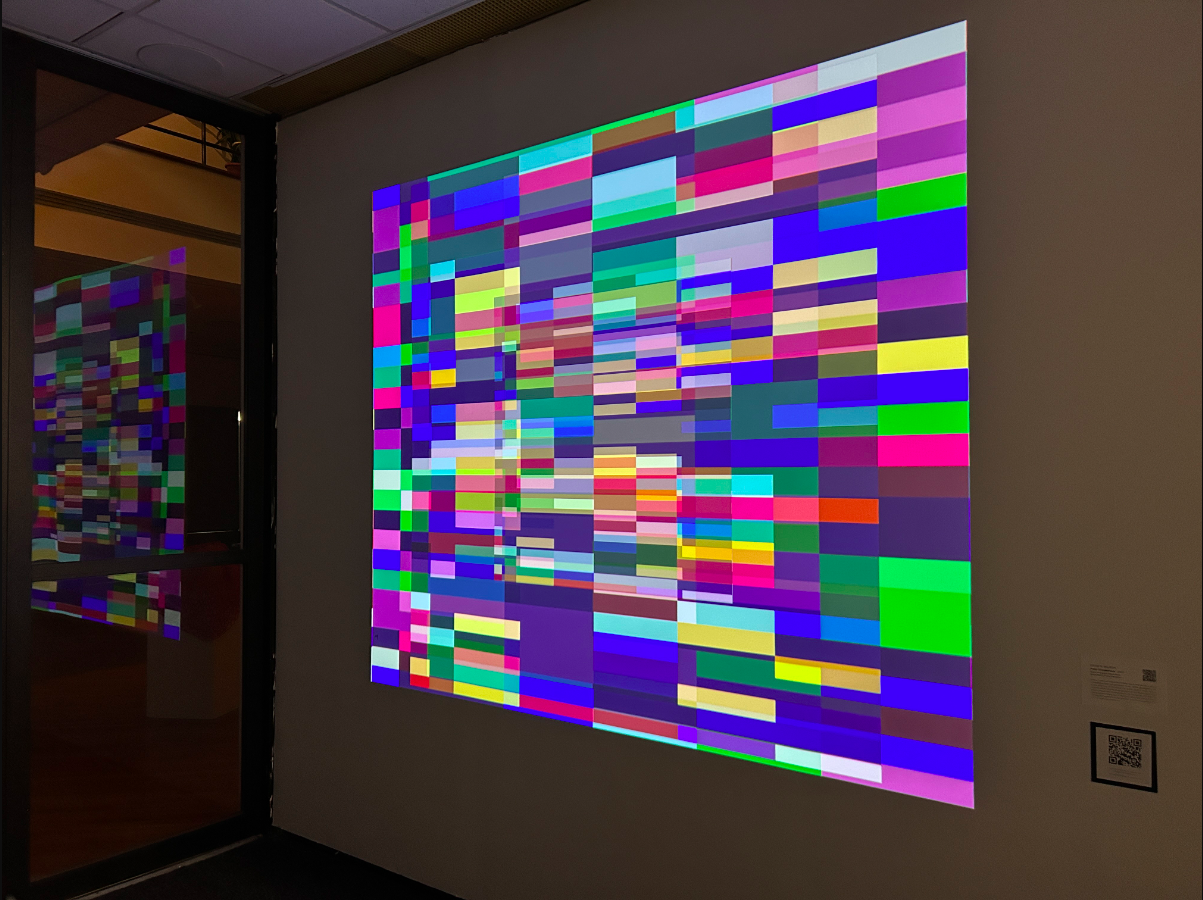
Public Chromesthesia on 2/24/25 6:30pm EST
During the four weeks it was active, there were several moments when I would check in on the LSAV, to notice it being altered. I observed that neon green and hot pink were two very popular colors that the public chose to apply to the piece. In terms of the backend technology for the SCA, no crashes or service disruptions were observed.
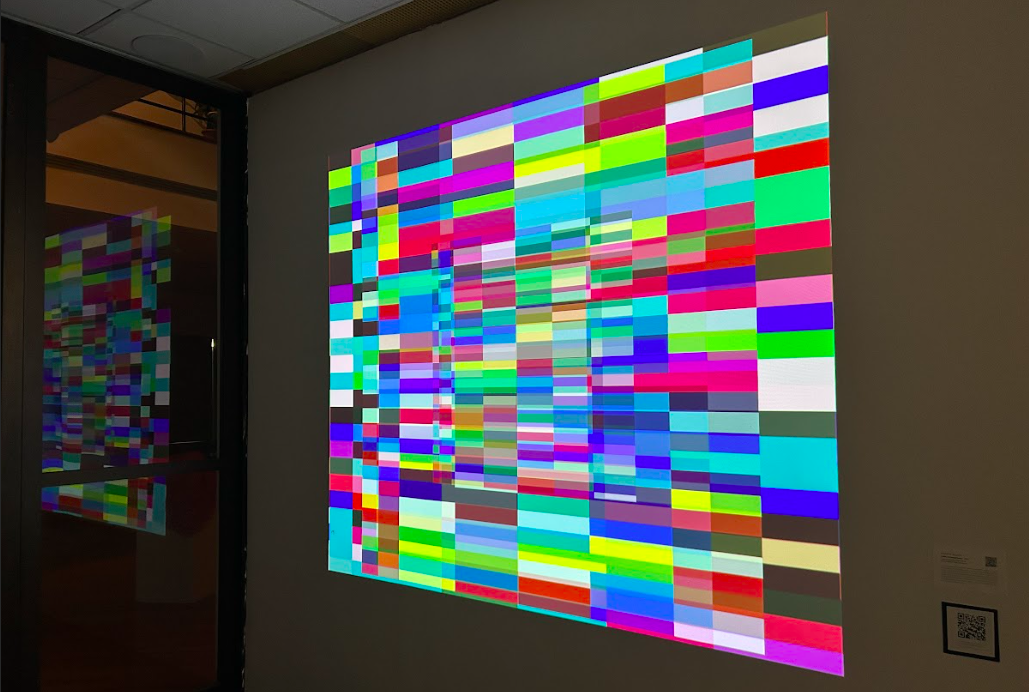
Public Chromesthesia on 3/03/25 6:20pm EST
However, the backend infrastructure supporting the LSAV did throw errors, on average about five per week. The most common error was that scripts within the LSAV did not respond to calls from the SCA to update content. To the best of my knowledge, the LSAV and SCA were up and in continuous service throughout the month long showing within the gallery.
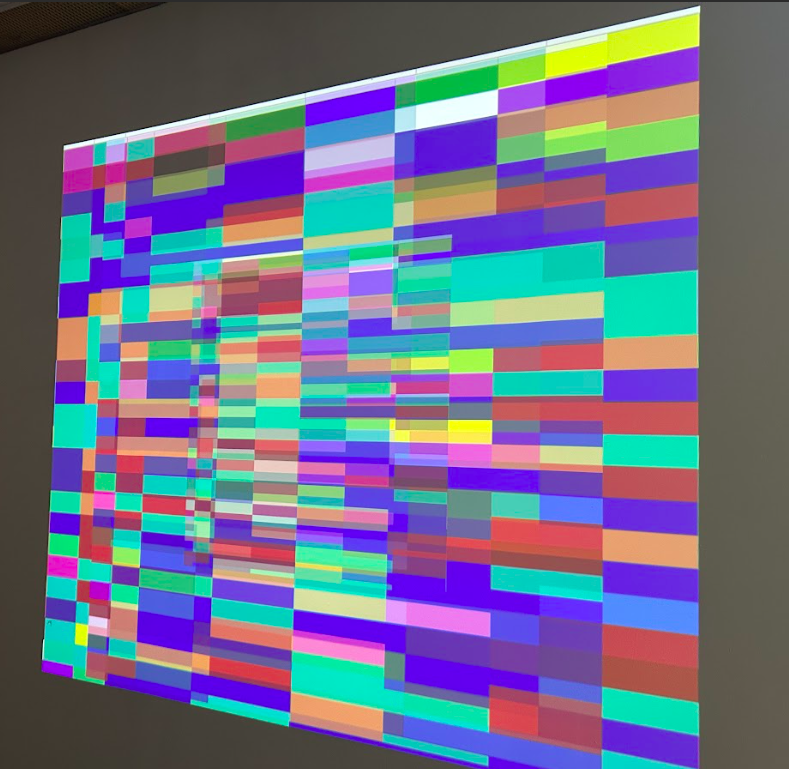
LSAV misbehaving on 3/10/25 11:40am EST
During week 3 the web browser displaying the LSAV within the gallery began to behave in an unexpected way. Note in the above image, the white seams that appear at the top and in the middle of the grid. Thank you to gallery staff Greg and Jerzy for allowing me access to the computer within the gallery in order to troubleshoot and remedy the issue. After careful observation I noticed that the troublesome browser was not completely loading the visual material, essentially in an unresolved state of loading. I decided to switch browsers which addressed the loading issue but changed the shape of the visual material from a rectangle to a square.

Public Chromesthesia on 3/14/25 6:40pm EST
As I have documented in other posts on this site, it is not unusual for public interactives to require fairly consistent upkeep. See notes on Connected Worlds, Times Square, and an upcoming post on Mercer Labs that document malfunctioning or non-functional components of public interactives at time of observation. From a design and engineering standpoint, a main concern when designing and deploying a public interactive is to engineer it in a manner prior to deployment knowing that upkeep will be required at some point, that the piece and infrastructure supporting it should be easily accessible. The piece should be engineered in a manner where troubleshooting is straight forward, if and when failure occurs that they happen as gracefully as possible without the piece completely crashing or shutting down. These concerns are in addition to designing and deploying content that is meaningful and engaging for audience and environment.
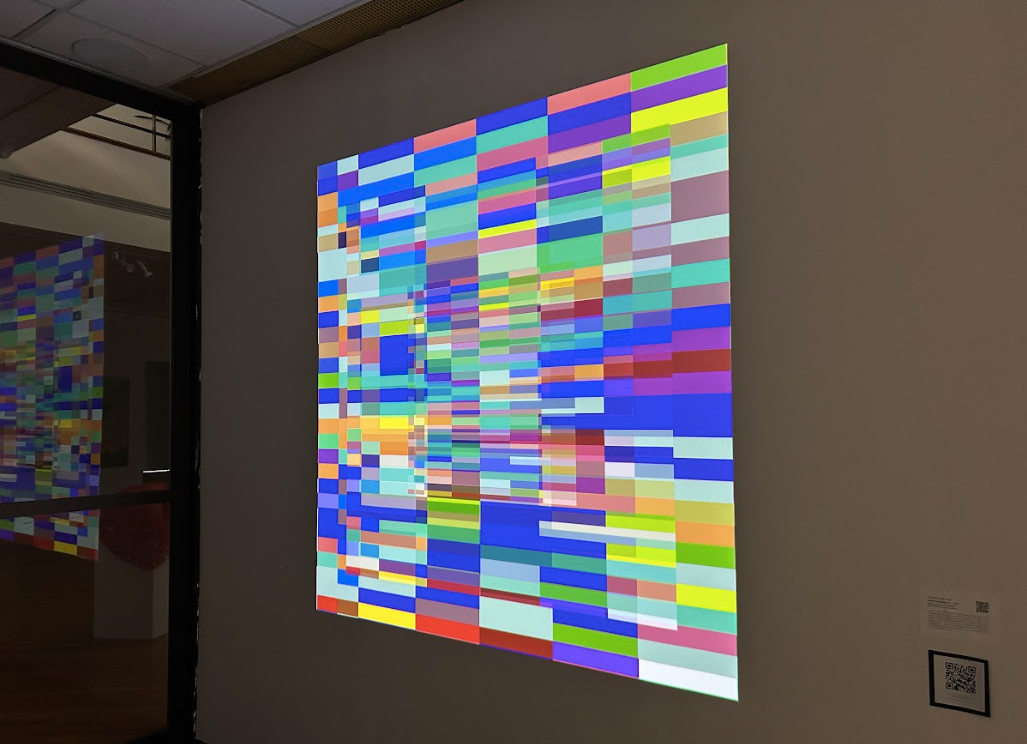
Public Chromesthesia on 3/17/25 10:40am EST
For future deployments of Public Chromesthesia, I would like to develop a control panel that features the ability to monitor what the projection within the deployment space looks like. I would like to do this carefully because I do not want the piece to monitor its surroundings or those within it. However, I would like the ability to be able to see what is being projected in real time, as it was clear during week 1 that because of interactor traffic, the LSAV projected within the gallery was not updating in real time. There were also different instances of LSAV that were accepting interaction that differed in appearance from the LSAV in the gallery.
I learned from this deployment that, in order for the sound component to be more impactful, audio speakers in-situ would be ideal, such that those within a deployment space could hear what they were contributing along with those who are with the piece virtually at the same time. I would also like to deploy the piece with a sturdy control surface so that those within a deployment space could perform the piece more centrally, to be able to collaborate with others using the SCA from wherever or however they are. I would also like to see the piece at a much larger scale, utilizing LED display panels rather than projection.
DnW 3/28/25
Public Chromesthesia, a public interactive digital mural, was deployed for the first time as part of the gallery show Shoulder Season, at the Richard and Dolly Maass Gallery on February 19th, 2025. Thank you to Purchase College and the School of Art+Design for the opportunity to present and observe the piece as part of research into Public Interactives over the course of a month long deployment....
Prior to opening night, I conducted as many stress tests as I could in the lab. As is usually the case with initial deployment of public interactives there are many surprises as the public is exceedingly unpredictable. These surprises usually include hardware, software, or infrastructural crashes due to unexpected or unanticipated stress or code bugs, etc. I am happy to report that despite a very busy first few hours on opening night deployment, Public Chromesthesia stood up and survived the rigor where none of its components crashed or threw catastrophic errors.
The piece has experienced no observable hardware or software crashes server side during week 1, though the LSAV did exhibit some unexpected behaviors on opening night due to increased demands on it and the SCA. The SCA did not throw any script or server errors as especially on opening night it was under considerable stress from about 5:30 to 6:30pm EST. According to reports from the field, SCA responsiveness slows a bit depending on traffic, internet connection type, and hardware within the interacting device. These behaviors are expected.
On opening night, due to demand, LSAV split into three known discrete live instances that were accepting interactions and displaying them browser side. However, the LSAV projected and shown in the gallery (LSAV1) was not displaying updates for most of the gallery opening. The reasons for this are unknown at this time. Given the backend infrastructure, it is expected that during times of heavy usage and requests live updating will slow significantly or stop altogether. I would like to understand how, given backend infrastructure, the LSAV split into three instances that were accepting input and how to display them concurrently. LSAV3 got "pink bombed" and looked amazing but unfortunately I don't think the public ever saw that version. I am wondering if there is a way to continually refresh content to the LSAV without forcing the entire browser instance to reload in an unsightly fashion. This caused an undesired strobing effect when tests of this nature were conducted in the lab prior to deployment.
During opening night I spent time engaging with the piece alongside a member of my immediate family. We are separated by significant distance and a few time zones, so it was very gratifying to get to co-engage with the piece in a public setting. At the time I had an instance of LSAV (LSAV2) open and a SCA both via desktop that seemed to be live updating as we were contributing and interacting with each other. At the time I was not aware that LSAV1 in the gallery was not reflecting these updates, but my family and I enjoyed building experiential bridges over space and time with the piece. Afterwards I reflected on about how helpless I felt during the pandemic, when I was forced to keep physically away from certain family members due to safety concerns with travel. Our engaging the piece reconfigured that horrible memory or recontextualized it, while we bridged our space/time separation to create a novel experience of a public interactive.

Public Chromesthesia 2/24/25 6:30pm EST
I am hoping to bring a team of students interested in public interactives to engage with Public Chromesthesia in the gallery before the show closes. I know from stress tests that when multiple people are creating sound with the piece simultaneously, very interesting distributed tonality happens. In terms of documentation I am taking nightly screen grabs of the LSAV, so that I can make an animated video that documents how the LSAV changed over its month long deployment. Based on the few screens grabs I have, I can already tell the video animation will look very compelling.
Based on this first week I would like to be able to create a virtual dashboard that displays the number of interactors who are currently connected to LSAV+SCA and when, as well as, to be able to understand when are peak usage times. I would also like the dashboard to show any instances of the LSAV that are currently accepting input. I want to be able to measure usage, not to track interactors. I can currently access some of this information via the backend infrastructure, but I feel there is a danger of interrupting the LSAV visualization when I do so.
DnW 2/25/25
Student Work

Christopher Raetz | Purchase Ink Archive
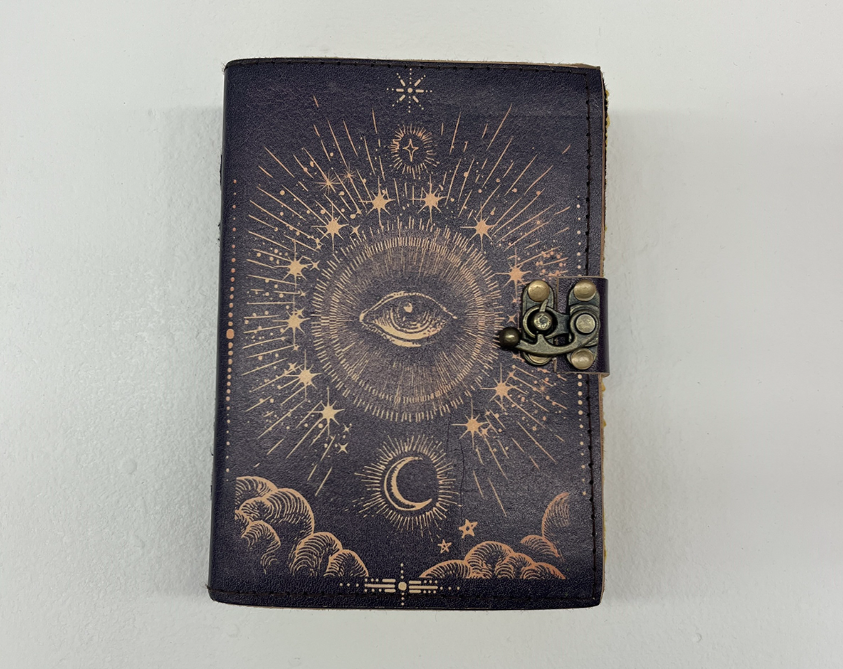
Mikaila McClinton-Thibault | Calls From the Crossroad Exhibition
Perception Census | A ground-breaking scientific study exploring the unique ways we each experience the world around us
Digital worlds that feel human | Ultraleap
LCD vs. LED: What's the Difference Between the Displays? | HowStuffWorks
5 years since COVID struck NYC - a look at how it changed how we live and work | Gothamist
Sherman Fairchild Foundation has awarded $500,000.00 to Purchase College to fund The TAPROOT Project through academic year 2028
What is NFC? How it works and what you can do with it | Digital Trends
Next up for CRISPR: Gene editing for the masses? | MIT Technology Review
Ray-Ban Meta smart glasses: a turning point - The Verge
Epson BrightLink 595Wi Interactive WXGA 3LCD Projector Review | PCMag
Tile Tracker | Bluetooth Trackers for Keys, Wallets, Phones, and More
Apple reveals iPhone 16 and Apple Intelligence AI features | Apple | The Guardian
How Reading Has Changed Literature Database
Leaflet.js Watch Position No Zoom Example
Leaflet.js Map Locate No Zoom Example
Public Chromesthesia
Shared piano prototype
Digital mural examples
The Online Gallery of Public Interactives
82 Reflections | Digital reflection and meditation
Public Chromesthesia Deployment Reflection
created with screen captures of the LSAV once a day for 30 days
Public Chromesthesia was successful during its month long deployment inside the Richard and Dolly Maass Gallery because it was a mural in motion, activated by interactors digital and non-digital. While the piece sometimes exhibited some unusual behaviors, it withstood the rigors of public deployment without any major crashes or disruptions. I'd like to once again offer my thanks and gratitude to Purchase College, The School of Art+Design, students, faculty, staff, and interactors from all over the world....

Public Chromesthesia on 2/24/25 6:30pm EST
During the four weeks it was active, there were several moments when I would check in on the LSAV, to notice it being altered. I observed that neon green and hot pink were two very popular colors that the public chose to apply to the piece. In terms of the backend technology for the SCA, no crashes or service disruptions were observed.

Public Chromesthesia on 3/03/25 6:20pm EST
However, the backend infrastructure supporting the LSAV did throw errors, on average about five per week. The most common error was that scripts within the LSAV did not respond to calls from the SCA to update content. To the best of my knowledge, the LSAV and SCA were up and in continuous service throughout the month long showing within the gallery.

LSAV misbehaving on 3/10/25 11:40am EST
During week 3 the web browser displaying the LSAV within the gallery began to behave in an unexpected way. Note in the above image, the white seams that appear at the top and in the middle of the grid. Thank you to gallery staff Greg and Jerzy for allowing me access to the computer within the gallery in order to troubleshoot and remedy the issue. After careful observation I noticed that the troublesome browser was not completely loading the visual material, essentially in an unresolved state of loading. I decided to switch browsers which addressed the loading issue but changed the shape of the visual material from a rectangle to a square.

Public Chromesthesia on 3/14/25 6:40pm EST
As I have documented in other posts on this site, it is not unusual for public interactives to require fairly consistent upkeep. See notes on Connected Worlds, Times Square, and an upcoming post on Mercer Labs that document malfunctioning or non-functional components of public interactives at time of observation. From a design and engineering standpoint, a main concern when designing and deploying a public interactive is to engineer it in a manner prior to deployment knowing that upkeep will be required at some point, that the piece and infrastructure supporting it should be easily accessible. The piece should be engineered in a manner where troubleshooting is straight forward, if and when failure occurs that they happen as gracefully as possible without the piece completely crashing or shutting down. These concerns are in addition to designing and deploying content that is meaningful and engaging for audience and environment.

Public Chromesthesia on 3/17/25 10:40am EST
For future deployments of Public Chromesthesia, I would like to develop a control panel that features the ability to monitor what the projection within the deployment space looks like. I would like to do this carefully because I do not want the piece to monitor its surroundings or those within it. However, I would like the ability to be able to see what is being projected in real time, as it was clear during week 1 that because of interactor traffic, the LSAV projected within the gallery was not updating in real time. There were also different instances of LSAV that were accepting interaction that differed in appearance from the LSAV in the gallery.
I learned from this deployment that, in order for the sound component to be more impactful, audio speakers in-situ would be ideal, such that those within a deployment space could hear what they were contributing along with those who are with the piece virtually at the same time. I would also like to deploy the piece with a sturdy control surface so that those within a deployment space could perform the piece more centrally, to be able to collaborate with others using the SCA from wherever or however they are. I would also like to see the piece at a much larger scale, utilizing LED display panels rather than projection.
DnW 3/28/25
Public Chromesthesia Week 1 Notes
Public Chromesthesia, a public interactive digital mural, was deployed for the first time as part of the gallery show Shoulder Season, at the Richard and Dolly Maass Gallery on February 19th, 2025. Thank you to Purchase College and the School of Art+Design for the opportunity to present and observe the piece as part of research into Public Interactives over the course of a month long deployment....
Prior to opening night, I conducted as many stress tests as I could in the lab. As is usually the case with initial deployment of public interactives there are many surprises as the public is exceedingly unpredictable. These surprises usually include hardware, software, or infrastructural crashes due to unexpected or unanticipated stress or code bugs, etc. I am happy to report that despite a very busy first few hours on opening night deployment, Public Chromesthesia stood up and survived the rigor where none of its components crashed or threw catastrophic errors.
The piece has experienced no observable hardware or software crashes server side during week 1, though the LSAV did exhibit some unexpected behaviors on opening night due to increased demands on it and the SCA. The SCA did not throw any script or server errors as especially on opening night it was under considerable stress from about 5:30 to 6:30pm EST. According to reports from the field, SCA responsiveness slows a bit depending on traffic, internet connection type, and hardware within the interacting device. These behaviors are expected.
On opening night, due to demand, LSAV split into three known discrete live instances that were accepting interactions and displaying them browser side. However, the LSAV projected and shown in the gallery (LSAV1) was not displaying updates for most of the gallery opening. The reasons for this are unknown at this time. Given the backend infrastructure, it is expected that during times of heavy usage and requests live updating will slow significantly or stop altogether. I would like to understand how, given backend infrastructure, the LSAV split into three instances that were accepting input and how to display them concurrently. LSAV3 got "pink bombed" and looked amazing but unfortunately I don't think the public ever saw that version. I am wondering if there is a way to continually refresh content to the LSAV without forcing the entire browser instance to reload in an unsightly fashion. This caused an undesired strobing effect when tests of this nature were conducted in the lab prior to deployment.
During opening night I spent time engaging with the piece alongside a member of my immediate family. We are separated by significant distance and a few time zones, so it was very gratifying to get to co-engage with the piece in a public setting. At the time I had an instance of LSAV (LSAV2) open and a SCA both via desktop that seemed to be live updating as we were contributing and interacting with each other. At the time I was not aware that LSAV1 in the gallery was not reflecting these updates, but my family and I enjoyed building experiential bridges over space and time with the piece. Afterwards I reflected on about how helpless I felt during the pandemic, when I was forced to keep physically away from certain family members due to safety concerns with travel. Our engaging the piece reconfigured that horrible memory or recontextualized it, while we bridged our space/time separation to create a novel experience of a public interactive.

Public Chromesthesia 2/24/25 6:30pm EST
I am hoping to bring a team of students interested in public interactives to engage with Public Chromesthesia in the gallery before the show closes. I know from stress tests that when multiple people are creating sound with the piece simultaneously, very interesting distributed tonality happens. In terms of documentation I am taking nightly screen grabs of the LSAV, so that I can make an animated video that documents how the LSAV changed over its month long deployment. Based on the few screens grabs I have, I can already tell the video animation will look very compelling.
Based on this first week I would like to be able to create a virtual dashboard that displays the number of interactors who are currently connected to LSAV+SCA and when, as well as, to be able to understand when are peak usage times. I would also like the dashboard to show any instances of the LSAV that are currently accepting input. I want to be able to measure usage, not to track interactors. I can currently access some of this information via the backend infrastructure, but I feel there is a danger of interrupting the LSAV visualization when I do so.
DnW 2/25/25
Student Work

Christopher Raetz | Purchase Ink Archive

Mikaila McClinton-Thibault | Calls From the Crossroad Exhibition
Perception Census | A ground-breaking scientific study exploring the unique ways we each experience the world around us
Digital worlds that feel human | Ultraleap
LCD vs. LED: What's the Difference Between the Displays? | HowStuffWorks
5 years since COVID struck NYC - a look at how it changed how we live and work | Gothamist
Sherman Fairchild Foundation has awarded $500,000.00 to Purchase College to fund The TAPROOT Project through academic year 2028
What is NFC? How it works and what you can do with it | Digital Trends
Next up for CRISPR: Gene editing for the masses? | MIT Technology Review
Ray-Ban Meta smart glasses: a turning point - The Verge
Epson BrightLink 595Wi Interactive WXGA 3LCD Projector Review | PCMag
Tile Tracker | Bluetooth Trackers for Keys, Wallets, Phones, and More
Apple reveals iPhone 16 and Apple Intelligence AI features | Apple | The Guardian
How Reading Has Changed Literature Database
Leaflet.js Watch Position No Zoom Example
Leaflet.js Map Locate No Zoom Example
Public Chromesthesia
Shared piano prototype
Digital mural examples
The Online Gallery of Public Interactives
82 Reflections | Digital reflection and meditation